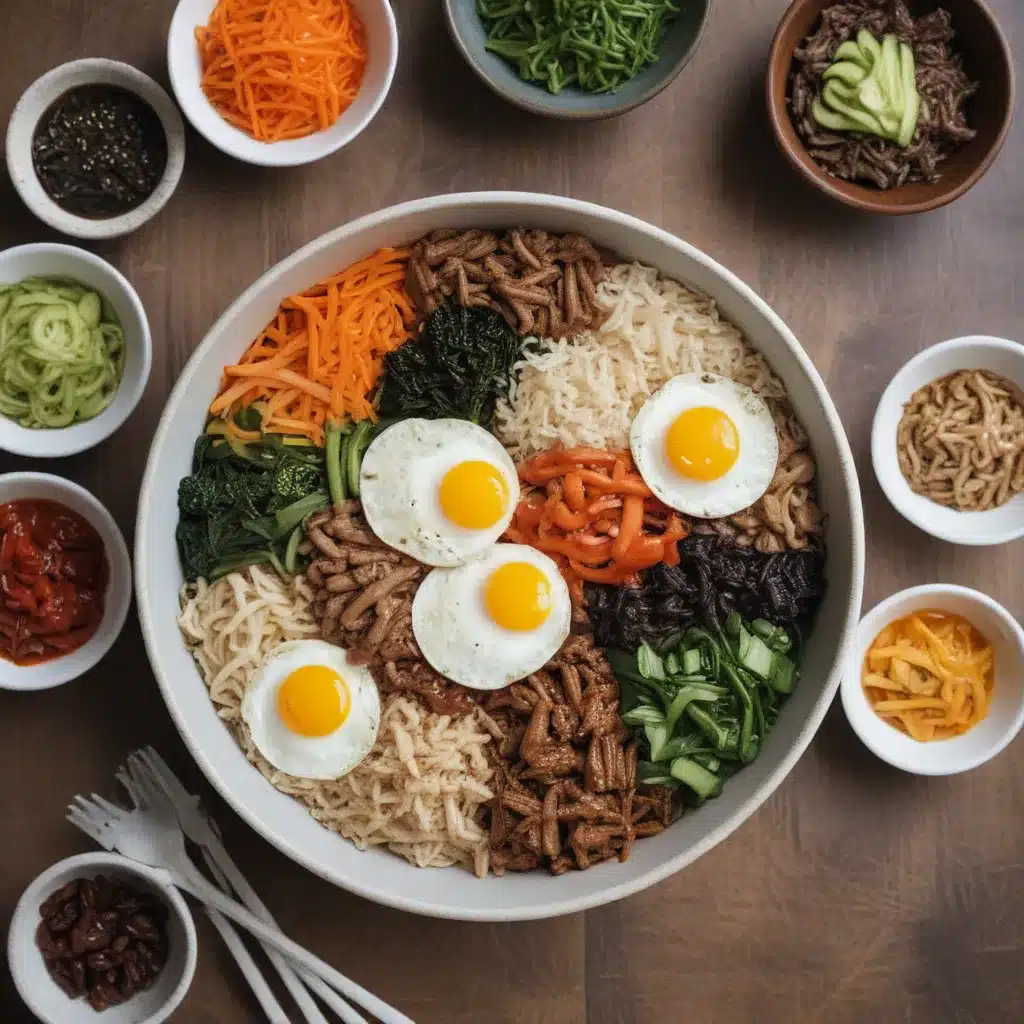
The Joys of Deconstructing Bibimbap
I’ll admit it – I’m a little obsessed with bibimbap. There, I said it! This Korean rice bowl dish has stolen a piece of my heart, and I’m not ashamed to say it. Sure, I may have previously professed my undying love for other Korean recipes, but this one truly has a special place in my culinary affections.
What is it about bibimbap that has me so captivated? Maybe it’s the vibrant array of sautéed, seasoned veggies that burst with flavor. Or the tender, marinated beef that melts in your mouth. Perhaps it’s the crowning glory – that glorious fried egg with its heavenly runny yolk, just waiting to be broken and mixed into the whole delectable mess.
But I think the real secret sauce (pun intended) is the gochujang-based bibimbap sauce. This spicy-sweet-savory elixir ties the whole dish together, elevating each ingredient to new heights of deliciousness. It’s the kind of sauce you could literally drink by the spoonful.
As the lovely folks at RecipeTin Eats put it, “the thing that really seals the deal is the bright red, spicy Bibimbap Sauce that I can’t get enough of. Mix it all up into one big delicious mess, then dig in!” Couldn’t have said it better myself.
Deconstructing the Deconstructed
Now, I know what you’re thinking – “But Nagi, isn’t bibimbap already deconstructed? How can you possibly deconstruct it further?” Well, my friends, that’s exactly what I’m about to do.
Let’s start with the star of the show – the bibimbap sauce. As the wise Facebook post reminds us, the key ingredient here is gochujang – that spicy, fermented Korean chili paste that lends an umami-packed punch. Combine it with some sweetness, a touch of vinegar, and a sprinkle of sesame seeds, and you’ve got a sauce that’s truly worthy of worship.
Next up, the protein. While the traditional version calls for thinly sliced beef, don’t be afraid to get creative. Chicken, pork, or even seafood can all be fantastic substitutes. The important thing is to keep the seasoning simple – a touch of soy, garlic, and sesame oil is all you need to let the bibimbap sauce shine.
Now for the veggies. This is where you can really let your culinary imagination run wild. Sautéed shiitake mushrooms, zucchini batons, wilted spinach, and crunchy bean sprouts are all classic choices. But don’t be afraid to mix it up with asparagus, peppers, or even kale. Just make sure to season each component with a light touch, as the bibimbap sauce will be doing the heavy lifting in the flavor department.
The Art of Assembly
Okay, so we’ve got all the individual elements prepped and ready to go. Now comes the fun part – assembling the bibimbap bowl.
The key here is to create a visually striking presentation. Arrange the various sautéed veggies in a rainbow-like pattern around the outer edge of the bowl. Nestle the protein of your choice in the center, then crown it all with that perfect fried egg.
As the wise Redditors remind us, when it comes to eating bibimbap, it’s all about the spoon, not the chopsticks. Use those trusty utensils to gently mix everything together, ensuring each bite is a delicious symphony of flavors and textures.
And don’t be stingy with that bibimbap sauce! Drizzle it generously over the top, then watch as it seeps down into the nooks and crannies, binding everything together in perfect harmony.
The Bibimbap Experience
Now, the real magic happens when you take that first bite. The runny yolk mingles with the spicy-sweet sauce, coating each morsel of meat and veggie in a glorious, umami-laden embrace. The contrasting textures – the crunch of the bean sprouts, the tender chew of the beef, the silky smooth egg – come together in a symphony of delight.
As the talented folks at Lady and Pups aptly described, “Part of the whole Bibimbap experience is how the bowl comes to you looking as pretty as a picture, then you get to dollop on as much Bibimbap Sauce as you want (I use about 2 tbsp), then after all that hard work preparing the bowls, you mix it all up and turn it into a delicious mess.”
That’s the beauty of bibimbap – it’s a dish that rewards both the eye and the palate. The artful presentation gives way to a gloriously messy, flavor-packed masterpiece. And with each subsequent bite, you’ll find yourself falling deeper and deeper in love.
So the next time you find yourself in a Korean restaurant, or hankering for a taste of Seoul in Boston, don’t hesitate – order that bibimbap. And this time, remember to hold the rice. The real magic happens when you let this deconstructed dish shine in all its glory.
